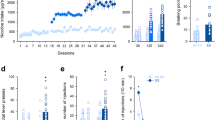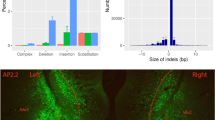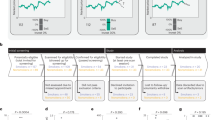Abstract
The CYP2B enzyme is expressed in human and rat brain, and metabolizes many CNS-acting drugs. The gene that encodes human CYP2B6 is highly polymorphic, where the variation in brain enzyme levels could result in altered brain drug levels. CYP2B can metabolize nicotine, the main psychoactive ingredient in cigarettes; if altered brain CYP2B activity can influence nicotine brain levels, it could influence nicotine-mediated behaviors. To investigate this, a mechanism-based inhibitor selective for CYP2B, C8-xanthate (20 μg), was administered intracerebroventricularly (ICV) into the brain of rats, and 22 h later, nicotine levels were measured by in vivo microdialysis following nicotine (150 μg/kg intravenous). Brain nicotine levels from 15 to 30 min and the AUC0–45min were both twofold higher (p<0.05) with C8-xanthate vs vehicle pretreatment; there was no difference in peripheral nicotine levels. Rats were then given ICV pretreatment with C8-xanthate/ASCF and underwent intravenous nicotine self-administration with 3.75–30 μg/kg per infusion dose. C8-xanthate pretreatment increased responding in progressive ratio (15 μg/kg per infusion dose, p<0.05). In a separate cohort, C8-xanthate increased the percentage of rats that acquired self-administration (7.5 μg/kg per infusion dose, p<0.05) from 40% after vehicle pretreatment to 100%, with no difference in peripheral nicotine levels measured at the end of behavior. In a third cohort, C8-xanthate increased the number of sessions required to meet extinction criteria (p<0.05). Together these data demonstrate that the brain CYP2B activity can influence nicotine brain levels and subsequent behaviors independent of hepatic metabolism. This suggests that human smokers with variable CYP2B brain levels could have different nicotine levels and reinforcement, which might have a role in smoking behaviors and dependence.
Similar content being viewed by others
Log in or create a free account to read this content
Gain free access to this article, as well as selected content from this journal and more on nature.com
or
References
Anandatheerthavarada HK, Boyd MR, Ravindranath V (1992). Characterization of a phenobarbital-inducible cytochrome P-450, NADPH-cytochrome P-450 reductase and reconstituted cytochrome P-450 mono-oxygenase system from rat brain. Evidence for constitutive presence in rat and human brain. Biochem J 288: 483–488.
Chiamulera C, Borgo C, Falchetto S, Valerio E, Tessari M (1996). Nicotine reinstatement of nicotine self-administration after long-term extinction. Psychopharmacology (Berl) 127: 102–107.
Corrigall WA, Coen KM (1989). Nicotine maintains robust self-administration in rats on a limited-access schedule. Psychopharmacology (Berl) 99: 473–478.
Craig EL, Zhao B, Cui JZ, Novalen M, Miksys S, Tyndale RF (2014). Nicotine pharmacokinetics in rats is altered as a function of age, impacting the interpretation of animal model data. Drug Metab Dispos 42: 1447–1455.
Crettol S, Deglon JJ, Besson J, Croquette-Krokkar M, Gothuey I, Hammig R et al (2005). Methadone enantiomer plasma levels, CYP2B6, CYP2C19, and CYP2C9 genotypes, and response to treatment. Clin Pharmacol Ther 78: 593–604.
Di Chiara G, Imperato A (1988). Drugs abused by humans preferentially increase synaptic dopamine concentrations in the mesolimbic system of freely moving rats. Proc Natl Acad Sci USA 85: 5274–5278.
Dobrinas M, Crettol S, Oneda B, Lahyani R, Rotger M, Choong E et al (2013). Contribution of CYP2B6 alleles in explaining extreme (S)-methadone plasma levels: a CYP2B6 gene resequencing study. Pharmacogenet Genomics 23: 84–93.
Donny EC, Caggiula AR, Mielke MM, Booth S, Gharib MA, Hoffman A et al (1999). Nicotine self-administration in rats on a progressive ratio schedule of reinforcement. Psychopharmacology (Berl) 147: 135–142.
Ekins S, Iyer M, Krasowski MD, Kharasch ED (2008). Molecular characterization of CYP2B6 substrates. Curr Drug Metab 9: 363–373.
Ferguson CS, Tyndale RF (2011). Cytochromes P450 enzymes in the brain: emerging evidence for biological significance. Trends Pharmacol Sci 32: 708–714.
Garcia KL, Le AD, Tyndale RF (2014). Effect of food training and training dose on nicotine self-administration in rats. Behav Brain Res 274: 10–18.
Gerber JG, Rhodes RJ, Gal J (2004). Stereoselective metabolism of methadone N-demethylation by cytochrome P4502B6 and 2C19. Chirality 16: 36–44.
Gervot L, Rochat B, Gautier JC, Bohnenstengel F, Kroemer H, de Berardinis V et al (1999). Human CYP2B6: expression, inducibility and catalytic activities. Pharmacogenetics 9: 295–306.
Hammond DK, Bjercke RJ, Langone JJ, Strobel HW (1991). Metabolism of nicotine by rat liver cytochromes P-450. Assessment utilizing monoclonal antibodies to nicotine and cotinine. Drug Metab Dispos 19: 804–808.
Hesse LM, Venkatakrishnan K, Court MH, von Moltke LL, Duan SX, Shader RI et al (2000). CYP2B6 mediates the in vitro hydroxylation of bupropion: potential drug interactions with other antidepressants. Drug Metab Dispos 28: 1176–1183.
Hoffmann E, O'Loughlin J, Karp I, Tyndale RF (2006) CYP2B6 and CYP2A6 Genotype: Impact on Acquisition of ICD10 Tobacco Dependence in Caucasian Adolescents. Society for Research on Nicotine and Tobacco: Orlando, FL, USA.
Jacob P 3rd, Ulgen M, Gorrod JW (1997). Metabolism of (-)-(S)-nicotine by guinea pig and rat brain: identification of cotinine. Eur J Drug Metab Pharmacokinet 22: 391–394.
Khokhar JY, Tyndale RF (2011). Drug metabolism within the brain changes drug response: selective manipulation of brain CYP2B alters propofol effects. Neuropsychopharmacology 36: 692–700.
Khokhar JY, Tyndale RF (2012). Rat brain CYP2B-enzymatic activation of chlorpyrifos to the oxon mediates cholinergic neurotoxicity. Toxicol Sci 126: 325–335.
Khokhar JY, Tyndale RF (2014). Intracerebroventricularly and systemically delivered inhibitor of brain CYP2B (C8-Xanthate), even following chlorpyrifos exposure, reduces chlorpyrifos activation and toxicity in male rats. Toxicol Sci 140: 49–60.
Kirchheiner J, Klein C, Meineke I, Sasse J, Zanger UM, Murdter TE et al (2003). Bupropion and 4-OH-bupropion pharmacokinetics in relation to genetic polymorphisms in CYP2B6. Pharmacogenetics 13: 619–626.
Lang T, Klein K, Fischer J, Nussler AK, Neuhaus P, Hofmann U et al (2001). Extensive genetic polymorphism in the human CYP2B6 gene with impact on expression and function in human liver. Pharmacogenetics 11: 399–415.
Lee AM, Jepson C, Hoffmann E, Epstein L, Hawk LW, Lerman C et al (2007a). CYP2B6 genotype alters abstinence rates in a bupropion smoking cessation trial. Biol Psychiatry 62: 635–641.
Lee AM, Jepson C, Shields PG, Benowitz N, Lerman C, Tyndale RF (2007b). CYP2B6 genotype does not alter nicotine metabolism, plasma levels, or abstinence with nicotine replacement therapy. Cancer Epidemiol Biomarkers Prev 16: 1312–1314.
Lee AM, Miksys S, Palmour R, Tyndale RF (2006). CYP2B6 is expressed in African Green monkey brain and is induced by chronic nicotine treatment. Neuropharmacology 50: 441–450.
Lerman C, LeSage MG, Perkins KA, O'Malley SS, Siegel SJ, Benowitz NL et al (2007). Translational research in medication development for nicotine dependence. Nature Rev Drug Discov 6: 746–762.
Markou A (2008). Review. Neurobiology of nicotine dependence. Philos Trans R Soc Lond B Biol Sci 363: 3159–3168.
Marshall DL, Redfern PH, Wonnacott S (1997). Presynaptic nicotinic modulation of dopamine release in the three ascending pathways studied by in vivo microdialysis: comparison of naive and chronic nicotine-treated rats. J Neurochem 68: 1511–1519.
McClernon FJ, Kozink RV, Rose JE (2007). Individual differences in nicotine dependence, withdrawal symptoms, and sex predict transient fMRI-BOLD responses to smoking cues. Neuropsychopharmacology 33: 2148–2157.
Miksys S, Hoffmann E, Tyndale RF (2000). Regional and cellular induction of nicotine-metabolizing CYP2B1 in rat brain by chronic nicotine treatment. Biochem Pharmacol 59: 1501–1511.
Miksys S, Lerman C, Shields PG, Mash DC, Tyndale RF (2003). Smoking, alcoholism and genetic polymorphisms alter CYP2B6 levels in human brain. Neuropharmacology 45.
Miksys S, Tyndale RF (2009). Brain drug-metabolizing cytochrome P450 enzymes are active in vivo, demonstrated by mechanism-based enzyme inhibition. Neuropsychopharmacology 34: 634–640.
Paxinos G, Watson C (1986) The Rat Brain in Stereotaxic Coordinates. 2nd edn. Academic Press: San Diego, CA, USA.
Rapier C, Lunt GG, Wonnacott S (1988). Stereoselective nicotine-induced release of dopamine from striatal synaptosomes: concentration dependence and repetitive stimulation. J Neurochem 50: 1123–1130.
Richter T, Murdter TE, Heinkele G, Pleiss J, Tatzel S, Schwab M et al (2004). Potent mechanism-based inhibition of human CYP2B6 by clopidogrel and ticlopidine. J Pharmacol Exp Ther 308: 189–197.
Sauer G, Amtmann E, Melber K, Knapp A, Muller K, Hummel K et al (1984). DNA and RNA virus species are inhibited by xanthates, a class of antiviral compounds with unique properties. Proc Natl Acad Sci USA 81: 3263–3267.
Schick HD, Amtmann E, Berdel WE, Danhauser-Riedl S, Reichert A, Steinhauser G et al (1989). Antitumoral activity of a xanthate compound. I. Cytotoxicity studies with neoplastic cell lines in vitro. Cancer Lett 46: 143–147.
Schilter B, Omiecinski CJ (1993). Regional distribution and expression modulation of cytochrome P-450 and epoxide hydrolase mRNAs in the rat brain. Mol Pharmacol 44: 990–996.
Shaham Y, Adamson LK, Grocki S, Corrigall WA (1997). Reinstatement and spontaneous recovery of nicotine seeking in rats. Psychopharmacology (Berl) 130: 396–403.
Shram MJ, Li Z, Le AD (2008). Age differences in the spontaneous acquisition of nicotine self-administration in male Wistar and Long-Evans rats. Psychopharmacology (Berl) 197: 45–58.
Siu EC, Wildenauer DB, Tyndale RF (2006). Nicotine self-administration in mice is associated with rates of nicotine inactivation by CYP2A5. Psychopharmacology (Berl) 184: 401–408.
Tsuchiya K, Gatanaga H, Tachikawa N, Teruya K, Kikuchi Y, Yoshino M et al (2004). Homozygous CYP2B6 *6 (Q172H and K262R) correlates with high plasma efavirenz concentrations in HIV-1 patients treated with standard efavirenz-containing regimens. Biochem Biophys Res Commun 319: 1322–1326.
Vieira-Brock PL, Miller EI, Nielsen SM, Fleckenstein AE, Wilkins DG (2011). Simultaneous quantification of nicotine and metabolites in rat brain by liquid chromatography–tandem mass spectrometry. J Chromatogr B 879 (30): 3465–3474.
Walsky RL, Astuccio AV, Obach RS (2006). Evaluation of 227 drugs for in vitro inhibition of cytochrome P450 2B6. J Clin Pharmacol 46: 1426–1438.
Yamanaka H, Nakajima M, Fukami T, Sakai H, Nakamura A, Katoh M et al (2005). CYP2A6 AND CYP2B6 are involved in nornicotine formation from nicotine in humans: interindividual differences in these contributions. Drug Metab Dispos 33: 1811–1818.
Yamazaki H, Inoue K, Hashimoto M, Shimada T (1999). Roles of CYP2A6 and CYP2B6 in nicotine C-oxidation by human liver microsomes. Arch Toxicol 73: 65–70.
Yanev S, Kent UM, Pandova B, Hollenberg PF (1999). Selective mechanism-based inactivation of cytochromes P-450 2B1 and P-450 2B6 by a series of xanthates. Drug Metab Dispos 27: 600–604.
Yanev SG, Kent UM, Roberts ES, Ballou DP, Hollenberg PF (2000). Mechanistic studies of cytochrome P450 2B1 inactivation by xanthates. Arch Biochem Biophys 378: 157–166.
Zanger UM, Klein K, Saussele T, Blievernicht J, Hofmann MH, Schwab M (2007). Polymorphic CYP2B6: molecular mechanisms and emerging clinical significance. Pharmacogenomics 8: 743–759.
Acknowledgements
We thank Fariba Baghai Wadji, Dr Bin Zhao, Maria Novalen, and Zhauxia Li for their technical assistance.
Author information
Authors and Affiliations
Corresponding author
Additional information
Supplementary Information accompanies the paper on the Neuropsychopharmacology website
Supplementary information
Rights and permissions
About this article
Cite this article
Garcia, K., Coen, K., Miksys, S. et al. Effect of Brain CYP2B Inhibition on Brain Nicotine Levels and Nicotine Self-Administration. Neuropsychopharmacol 40, 1910–1918 (2015). https://doi.org/10.1038/npp.2015.40
Received:
Revised:
Accepted:
Published:
Issue date:
DOI: https://doi.org/10.1038/npp.2015.40
This article is cited by
-
Characterization of the Stereoselective Disposition of Bupropion and Its Metabolites in Rat Plasma and Brain
European Journal of Drug Metabolism and Pharmacokinetics (2023)



